 Next week we will have an excellent maths worksheet showing how to do standard written addition with 4-digit numbers. Also there will be a page on finding lengths of time using both analogue and digital displays. Time is often a stumbling block for many children, especially when asked to find how long it is between two times.
Next week we will have an excellent maths worksheet showing how to do standard written addition with 4-digit numbers. Also there will be a page on finding lengths of time using both analogue and digital displays. Time is often a stumbling block for many children, especially when asked to find how long it is between two times.
There will also be mental arithmetic for Year 5 children on adding decimal fractions – by no means easy! Great practice over the holiday at keeping those mental arithmetic skills razor sharp!
Maths Worksheet: Add 19 to any 2-digit Number
 By year 4 children should be comfortable with 2-digit addition ‘in their heads’. This maths worksheet on adding 19 to any 2-digit number will show whether they are confident and quick with their mental methods.
By year 4 children should be comfortable with 2-digit addition ‘in their heads’. This maths worksheet on adding 19 to any 2-digit number will show whether they are confident and quick with their mental methods.
There are usually two processes involved when adding 19. It is often best done by adding twenty and subtracting one, although some children may well add ten and then add 9. This is easier and quicker than writing the sum down in columns and adding up using the standard method.
Resource of the Week: Year 5 Probability
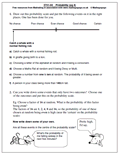 This week I am highlighting our probability worksheets for Year 5.
This week I am highlighting our probability worksheets for Year 5.
Probability is one of the least understood of maths concepts, especially with young children.
By year 5 children are expected to be able to say whether events are impossible , unlikely , likely or certain.
They should also be able to say which events have an even chance of happening (such as tossing a coin and getting a head), but they should be careful not to say that if there are two possibilities, they are equally likely. For example, there are two possibilities – I might buy a new Jaguar today or I might not. Unfortunately, these two events are not equally likely.
Another example of this is if I choose a number between 1 and 5. Is the number I choose a prime number? As there are three prime numbers between 1 and 5 (2, 3 and 5) and two numbers that are not, there is not an even chance that I will choose a prime number; rather there is a 3 in 5 chance, or 60% chance.
Subtraction of money
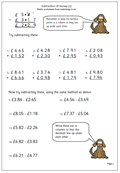 This is another in our series of worksheets covering the four rules. Children should be competent with the standard written method of subtraction before moving onto subtracting decimals. Money is an excellent way to show how decimals work and it is important to ensure that there are two numbers after the decimal point. Another key point, of course, is to make sure the columns are correctly in line and that a decimal point is included in the answer. Make sure that questions 9 to 15 are written out in the correct format: vertically rather than horizontally.
This is another in our series of worksheets covering the four rules. Children should be competent with the standard written method of subtraction before moving onto subtracting decimals. Money is an excellent way to show how decimals work and it is important to ensure that there are two numbers after the decimal point. Another key point, of course, is to make sure the columns are correctly in line and that a decimal point is included in the answer. Make sure that questions 9 to 15 are written out in the correct format: vertically rather than horizontally.
Year 2 maths worksheet: Missing numbers on a number square (2)
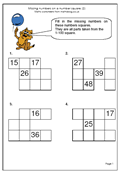 This is our second in a series for year 2 children where they have to complete the missing numbers in a 100 square. Some of the squares have been removed from the rectangles which, curiously, seems to make this task harder than when working with a complete rectangle. This is good practice for children who are not confident with counting up to 100. Don’t be surprised if children stumble over counting up to 100 out loud. It is something we often take for granted, but of course, has to be learned.
This is our second in a series for year 2 children where they have to complete the missing numbers in a 100 square. Some of the squares have been removed from the rectangles which, curiously, seems to make this task harder than when working with a complete rectangle. This is good practice for children who are not confident with counting up to 100. Don’t be surprised if children stumble over counting up to 100 out loud. It is something we often take for granted, but of course, has to be learned.
Coming Soon: Mental arithmetic and written subtraction
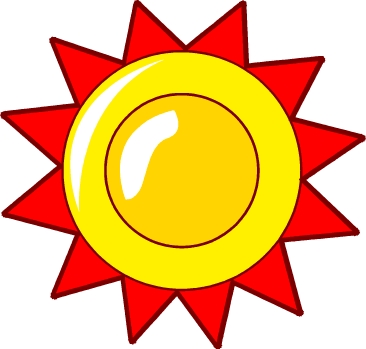 Holiday time is upon us now, although the promised hot summer has not materialised yet! To pass away a few idle moments, or to keep the brain in trim ready for next term we have both mental and written methods of calculating coming next week.
Holiday time is upon us now, although the promised hot summer has not materialised yet! To pass away a few idle moments, or to keep the brain in trim ready for next term we have both mental and written methods of calculating coming next week.
Mental arithmetic is the core of number work in the primary school as later written methods depend entirely upon successful mental methods. Next week we have page on how to add 19 to any 2-digit number and a great little page for Year 2 children on missing numbers on a number square. In our Four Rules section we will be looking at subtraction of money, including the decimal point, using the standard written method of subtraction.
Amazing date: August 7th 2009: 040506070809 or 123456789
 Two truly amazing times will shortly be with us – but only for a second each.
Two truly amazing times will shortly be with us – but only for a second each.
At 5 minutes and six seconds after 4 am the time will be o4:05:06.
On August 7th the date will be 07/08/09.
Put these two together, so at 5 minutes and six seconds after 4 am on August 7th 2009 the time and date will be:
04 05 06 07 08 09
This will not happen again so enjoy the moment.
 Perhaps even better a few hours later the time will be 12 hr 34 minutes and 56 seconds or 12:34:56, so at 12:34 and 56 seconds on 7th August 2009 the date will be:
Perhaps even better a few hours later the time will be 12 hr 34 minutes and 56 seconds or 12:34:56, so at 12:34 and 56 seconds on 7th August 2009 the date will be:
12 34 56 7 8 9
A unique time to be enjoyed by all!!
(As usual the Americans have jumped the gun as they show the month before the day but we all know this is the right way to do it!).
Year 3 Maths worksheet: Money problems
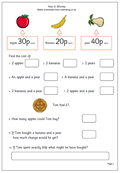 This is the first of a new series of maths worksheets for Year 3 on money and shopping problems. This page looks at addition of whole tens at the greengrocers, working with multiples of 10p.
This is the first of a new series of maths worksheets for Year 3 on money and shopping problems. This page looks at addition of whole tens at the greengrocers, working with multiples of 10p.
These questions should be solved mentally, although children may want to make jottings to help them. Most only need one operation to work out although the later questions involve both addition and subtraction.
Resource of the Week: Counting games for early years
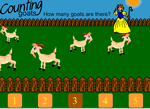 We have a great set of fun maths games for Reception/Early Years and one of my particular favourites is the Counting Goats game. This is really good practice at counting up to 5. Young children can not get too much practice with this both in the home and on the computer. They may well use their fingers to help and count out loud, but after a time they will begin to count in their heads. Adults can often glimpse at a picture to see how many there are, almost without counting – don’t expect this of 5 a year old!
We have a great set of fun maths games for Reception/Early Years and one of my particular favourites is the Counting Goats game. This is really good practice at counting up to 5. Young children can not get too much practice with this both in the home and on the computer. They may well use their fingers to help and count out loud, but after a time they will begin to count in their heads. Adults can often glimpse at a picture to see how many there are, almost without counting – don’t expect this of 5 a year old!
Don’t forget to click on the banjo playing goat at the end for a happy tune!
Mental arithmetic: Subtract 9 mentally
 Here we have a straightforward mental arithmetic worksheet on subtracting 9 from any 2-digit number. Usually the best way to do this is to subtract ten and then add one. Probably the only time that this is not the best way is if the number to take 9 from also has a 9 in the units.
Here we have a straightforward mental arithmetic worksheet on subtracting 9 from any 2-digit number. Usually the best way to do this is to subtract ten and then add one. Probably the only time that this is not the best way is if the number to take 9 from also has a 9 in the units.
Knowing this quick technique gives children confidence and they can then move on to subtracting 19, 29, 39….. etc in their heads.